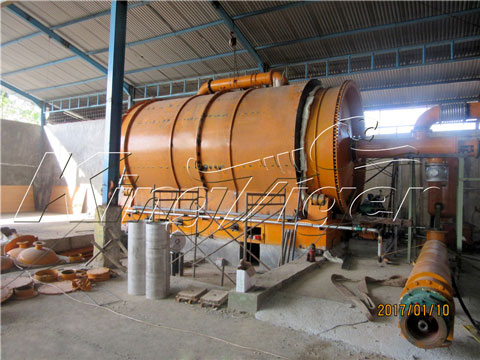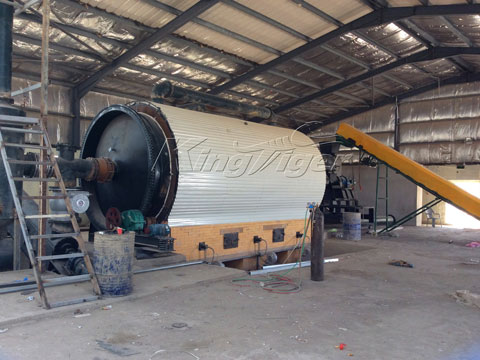Poor management of solid wastes resulting from increased industrialization, urbanization and population has led to wastes being disposed into waters and the environment resulting in pollution. Waste management systems have been put into place in order to better manage the solid waste to reduce pollution. These systems include recycling of solid wastes such as tyres, plastics and biomass by the process of pyrolysis to generate useful products such as bio-oil, biogas, tar and charcoal by use of a solid waste pyrolysis plant.
A pyrolysis plant works on the principal of carbonization where the solid wastes are heated at very high temperatures in the absence of oxygen to produce valuable products.
Before pyrolysis of solid waste is carried out, it is essential to separate the solid waste so as to remove materials such as glass and stones which cannot undergo pyrolysis.

The various feedstock used in a solid waste pyrolysis plant include
- Plastics: Pyrolysis of plastics results in the generation of biofuel which can be used in boilers and generators.
- Rubber and tyres: burning of waste tyres can result in the production of poisonous gases into the environment. Pyrolysis of rubber and tyres can produce bio-oil, biogas and carbon black.
- Agricultural wastes, paper and wood can undergo pyrolysis resulting in the production of biochar, bio-oil, charcoal, tar, wood vinegar and carbon black all having different uses in different industries.
Types of pyrolysis employed in a solid waste pyrolysis plant
1. Slow pyrolysis
This is a conventional type of pyrolysis that is employed mostly in the production of charcoal. This type of pyrolysis uses low heating temperatures and low heating rates that increase the amount of charcoal produced while reducing the amount of liquid and gaseous products produced.
2. Fast pyrolysis
This type of pyrolysis is employed in modern pyrolysis system and is used in the production of liquid and gaseous products.
It employs high heating rates and high temperatures that result in a high yield of the final product compared to slow pyrolysis.
3. Flash pyrolysis
This is a more developed version of pyrolysis when compared with fast pyrolysis. It has very high heating rates but is disadvantageous because the resulting end product is not very stable.

Components of a solid waste pyrolysis plant
A reactor: this constitutes the heating component of a solid waste pyrolysis plant where carbonization takes place. Different types of reactors are used by different pyrolysis plants depending on the size and type of feedstock used. These include;- fixed bed reactors- fluidized bed reactors that are either bubbled or circulating reactors.
- – Entrained flow reactor
- -vacuum furnace reactors
- – Ablative reactors
- -rotating cone reactor
- – Auger reactor
- – Solar reactor
- – Plasma reactor
A crushing and drying system: it cuts and grinds the feedstock into the required size and then dry the feedstock to reduce the water content.
A conveyor belt: it will direct the dried feedstock into the reactor.
A cooling system: it will cool down the final products after completion or during pyrolysis.
A hydro seal system that purifies the gaseous products.
A discharge system: it allows removal of final products from the pyrolysis machine. Click pyrolysis plant price for quote.
How a solid waste pyrolysis plant works
The feedstock is first crushed into the required size by use of the crushing system. The crushed solid waste is then directed into the drying system where the moisture content is reduced by drying. The dried solid waste is conveyed from the drying system into the reactor where the process of carbonization takes place. The reactor is heated at high temperatures in the absence of oxygen resulting in sequential production of various products. First combustible gases are produced which are directed into the hydro seal system where they are purified and cooled by the cooling system producing oil. The remaining gas is channelled back for reuse as a source of fuel in the reactor. This is followed by the removal of tar and other solid products such as biochar and charcoal from the discharge system.
Various parameters to consider during the pyrolysis process
The heating temperature and reaction timeThe final product is highly determined by the heating rates and reaction time. This is because these parameters determine the quality, quantity and composition of the product thus need to be highly monitored.
The feedstock
The type of feedstock used for pyrolysis determines the final product. This is because the chemical composition of various feedstock varies and thus the final product will also vary depending on the feedstock used.
Uses of various products of a solid waste pyrolysis machine
- Bio oil is used as a substitute for fuel in various industries.
- Biochar is used in various agricultural practices to improve the yield of produce.
- Wood vinegar is used in the food industries as a preservative.
- Syngas can be used as a source of fuel in industrial processes.
Advantages of using a solid waste pyrolysis plant
- It is cost effective and cheap since most of the processes are automated.
- It is an effective way of curbing environmental pollution.
- Useful final products are obtained by the process.